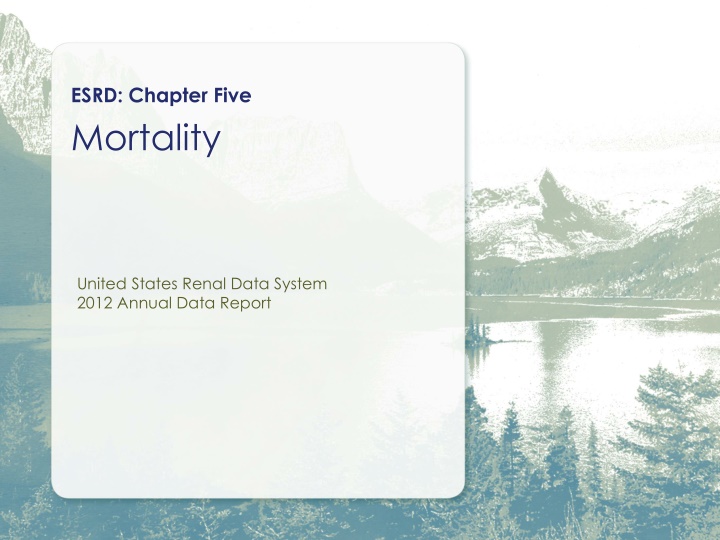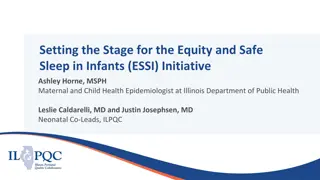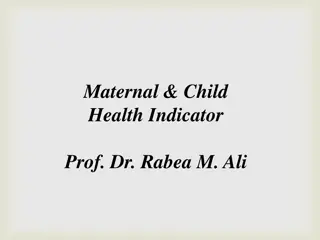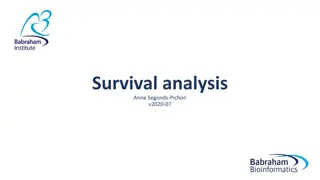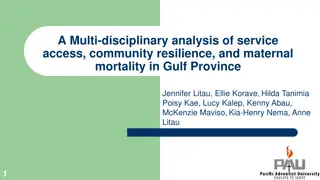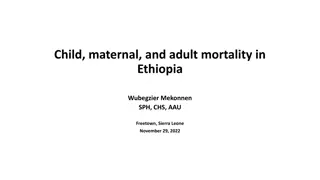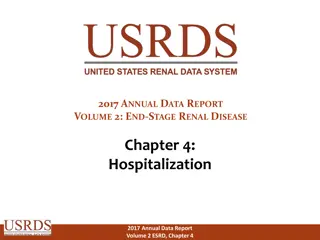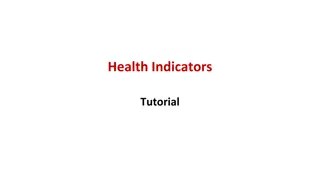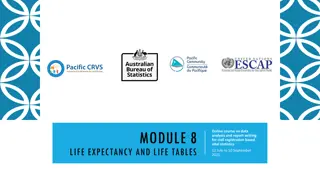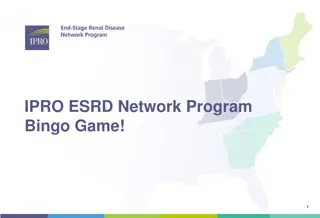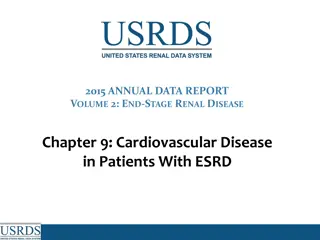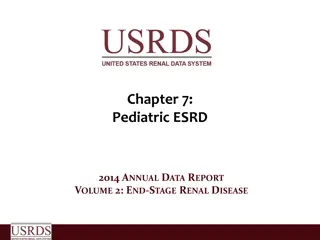ESRD Mortality Rates and Survival Probabilities Overview
This content presents various data on adjusted all-cause mortality rates and survival probabilities in End-Stage Renal Disease (ESRD) patients, focusing on different modalities, demographics, and treatment years. Figures and tables from the United States Renal Data System's 2012 Annual Data Report illustrate the mortality trends and outcomes in incident and prevalent ESRD patients, comparing them with the general population and analyzing survival probabilities from day one of dialysis or transplant. The information offers valuable insights for understanding mortality patterns and survival expectations in ESRD populations.
Download Presentation

Please find below an Image/Link to download the presentation.
The content on the website is provided AS IS for your information and personal use only. It may not be sold, licensed, or shared on other websites without obtaining consent from the author.If you encounter any issues during the download, it is possible that the publisher has removed the file from their server.
You are allowed to download the files provided on this website for personal or commercial use, subject to the condition that they are used lawfully. All files are the property of their respective owners.
The content on the website is provided AS IS for your information and personal use only. It may not be sold, licensed, or shared on other websites without obtaining consent from the author.
E N D
Presentation Transcript
ESRD: Chapter Five Mortality United States Renal Data System 2012 Annual Data Report
Adjusted all-cause mortality rates (from day 90), by modality & year of treatment Figure 5.1 (Volume 2) Incident ESRD patients. Adj: age/gender/race /primary diagnosis; ref: incident ESRD patients, 2005. USRDS 2012 ADR
Adjusted all-cause mortality in the ESRD & general populations, by age, 2010 Figure 5.2 (Volume 2) Prevalent ESRD & general Medicare (non-ESRD) patients. Adj: gender/race; ref: Medicare patients, 2010. USRDS 2012 ADR
Adjusted all-cause & cause specific mortality (from day one) in the first year of hemodialysis Figure 5.3 (Volume 2) Incident hemodialysis patients defined on the day of dialysis onset, without the 60-day rule. Adj: age/gender /race/Hispanic ethnicity/ primary diagnosis; ref: incident hemodialysis patients, 2005. USRDS 2012 ADR
Adjusted all-cause mortality in prevalent hemodialysis patients, by vintage Figure 5.4 (Volume 2) Incident hemodialysis patients. Adj: age/gender/race/primary diagnosis; ref: incident hemodialysis patients, 2005. USRDS 2012 ADR
Adjusted survival probabilities, from day one, in the ESRD population Table 5.a (Volume 2) Incident dialysis patients defined on the day of dialysis onset, without the 60-day rule from day one of dialysis to December 31, 2010; transplant patients receiving a first transplant in the calendar year, followed from day of transplant to December 31, 2010. Adj: age/gender/race/ Hispanic ethnicity/primary diagnosis; ref: incident ESRD patients, 2005. USRDS 2012 ADR
Adjusted survival probabilities, from day one, in the ESRD population Table 5.a (continued; Volume 2) Incident dialysis patients defined on the day of dialysis onset, without the 60-day rule from day one of dialysis to December 31, 2010; transplant patients receiving a first transplant in the calendar year, followed from day of transplant to December 31, 2010. Adj: age/gender/race/ Hispanic ethnicity/primary diagnosis; ref: incident ESRD patients, 2005. USRDS 2012 ADR
Unadjusted & adjusted mortality rates in the ESRD & general Medicare populations, age 65 & older (per 1,000 patient years at risk) Table 5.b (Volume 2) January 1 point prevalent ESRD & general Medicare patients age 65 & older. Adj: age/gender/race /comorbidity; ref: ESRD patients, 2005. USRDS 2012 ADR
Adjusted all-cause mortality rates in the ESRD & general populations, by age & gender, 2010 Figure 5.5 (Volume 2) January 1 point prevalent ESRD & general Medicare patients age 65 & older. Adj: age/gender/race/ comorbidity; ref: 2010 ESRD patients. USRDS 2012 ADR
Adjusted all-cause mortality rates in the ESRD & general populations, by race & gender, 2010 Figure 5.6 (Volume 2) January 1 point prevalent ESRD & general Medicare patients age 65 & older. Adj: age/gender/race/ comorbidity; ref: 2010 ESRD patients. USRDS 2012 ADR
Annualized all-cause mortality rates on different days of the dialysis week, 2010 Figure 5.7 (Volume 2) January 1, 2010 point prevalent Medicare hemodialysis patients alive on January 31. Includes patient age 20 & older receiving hemodialysis three times weekly on a Monday Wednesday Friday or Tuesday Thursday Saturday schedule; HD1, HD2, & HD3, are the first, second, & third hemodialysis sessions. Rates for all patients are adjusted for age, gender, race, Hispanic ethnicity, & primary diagnosis; rates by age are adjusted for the other four factors. Ref: all included hemodialysis patients in 2010. USRDS 2012 ADR
Annualized cardiovascular mortality rates on different days of the dialysis week, 2010 Figure 5.8 (Volume 2) January 1, 2010 point prevalent Medicare hemodialysis patients alive on January 31. Includes patient age 20 & older receiving hemodialysis three times weekly on a Monday Wednesday Friday or Tuesday Thursday Saturday schedule; HD1, HD2, & HD3, are the first, second, & third hemodialysis sessions. Rates for all patients are adjusted for age, gender, race, Hispanic ethnicity, & primary diagnosis; rates by age are adjusted for the other four factors. Ref: all included hemodialysis patients in 2010. USRDS 2012 ADR
Annualized rates of mortality due to infection on different days of the dialysis week, 2010 Figure 5.9 (Volume 2) January 1, 2010 point prevalent Medicare hemodialysis patients alive on January 31. Includes patient age 20 & older receiving hemodialysis three times weekly on a Monday Wednesday Friday or Tuesday Thursday Saturday schedule; HD1, HD2, & HD3, are the first, second, & third hemodialysis sessions. Rates for all patients are adjusted for age, gender, race, Hispanic ethnicity, & primary diagnosis; rates by age are adjusted for the other four factors. Ref: all included hemodialysis patients in 2010. USRDS 2012 ADR
Annualized all-cause mortality rates (per 1,000 patient years) on days after the long & short interdialytic intervals & on days without dialysis, 2010 Table 5.c (Volume 2) January 1, 2010 point prevalent Medicare hemodialysis patients alive on January 31. Includes patients age 20 & older receiving hemodialysis three times weekly on a Monday Wednesday Friday or Tuesday Thursday Saturday schedule. Rates for all patients, & groups by ESRD duration, are adjusted for age, gender, race, Hispanic ethnicity, & primary diagnosis; rates by age, gender, & primary diagnosis are adjusted for the other four factors. Rates by race & ethnicity are adjusted for age, gender, & primary diagnosis. Ref; all included hemodialysis patients in 2010. USRDS 2012 ADR
